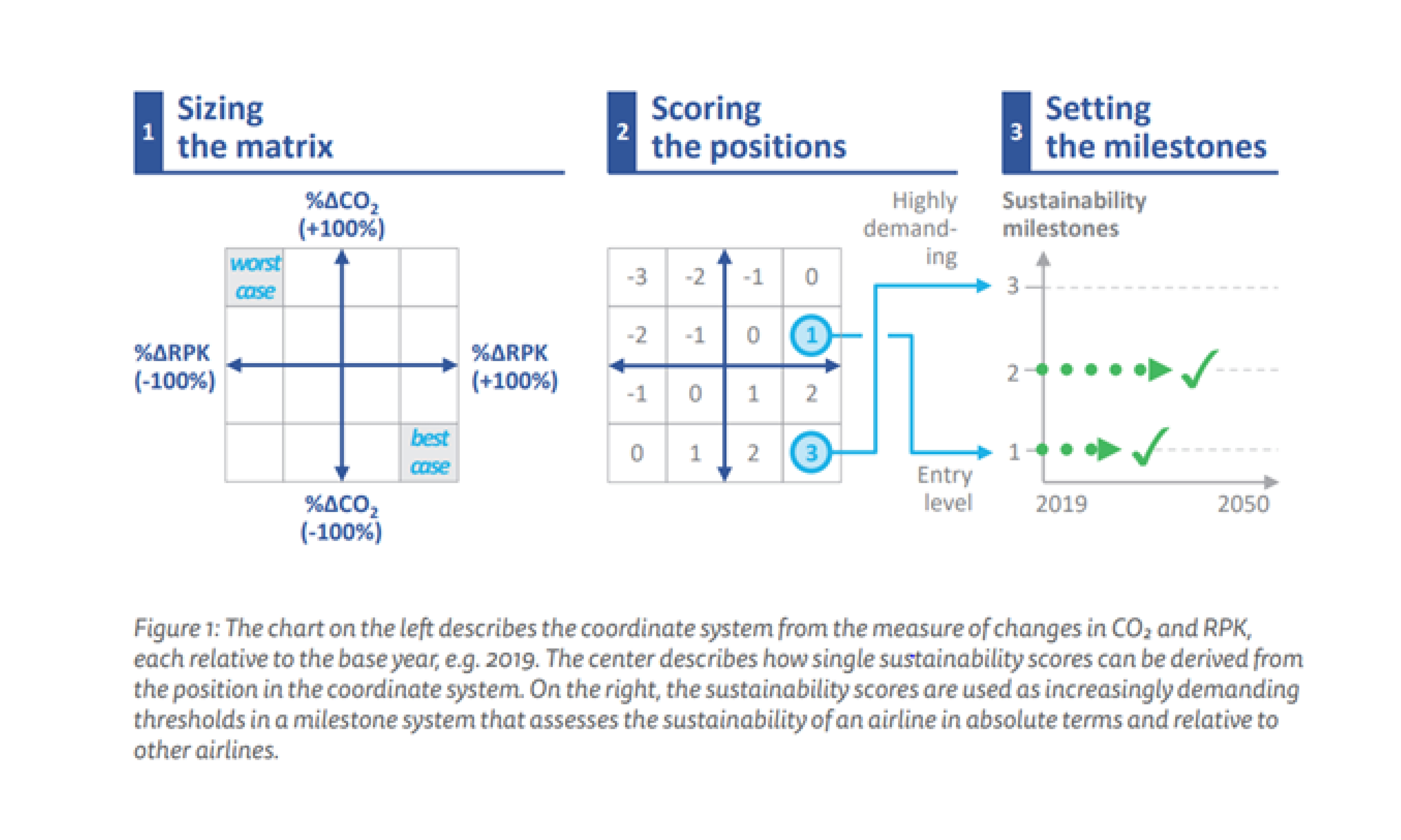
Publication
Trademark tussles just got spicier: Canada now offers costs awards
Costs awards in trademark opposition proceedings have been long anticipated in Canada.


Global | Publication | June 2023
Aviation is an essential tool for global mobility, but is a 'hard-to-abate' sector, meaning it is prohibitively costly or impossible to transition to net-zero with currently available abatement technology. However, sustainability improvements are possible and finance is a powerful tool to incentivize airlines and operating lessors to pursue these improvements.
There are fundamentally two types of loan instrument on offer to help companies finance their sustainability goals: use of proceeds loans and sustainability-linked loans1 (SLLs).
Use of proceeds instruments – being green and/or social loans – provide financing for standalone 'green' and/or 'social' projects. SLLs, on the other hand, focus instead on supporting a borrower in improving its sustainability performance, via the achievement (or not) of predetermined sustainability performance targets (SPTs). As a result, the proceeds may be used to finance any kind of business activities that the borrower is pursuing, rather than being tied to the financing of a particular asset.
Whilst the green loan structure has been used for a small number of aviation-related finance deals in the past, the SLL has more recently been the favored instrument in the aviation sector due to its inherently flexible nature, being borrower-focused and sector agnostic, as well as avoiding concerns that a green loan specifying the current generation of aircraft as a ‘green’ asset could be seen as greenwashing. As such, we shall focus this article on how best to use a SLL in an aviation finance transaction.
SLLs are defined as “…any types of loan instruments and/or contingent facilities (such as bonding lines, guarantee lines or letters of credit) for which the economic characteristics can vary depending on whether the borrower achieves ambitious, material and quantifiable predetermined sustainability performance objectives”,2 and which comply with the five core components of the SLLP.
SLLs aim to support a borrower’s efforts in improving its sustainability profile over the term of the loan. They do so by aligning loan terms to the borrower’s performance, which is measured using one or more sustainability KPIs that can be internal and/or external.
Some notable SLLs in the aviation sector have covered the full gambit of E, S and G – Etihad’s 2021 US$1.2 billion SLL included KPIs measuring improvements in CO2 emissions intensity of its passenger fleet, better corporate governance as measured under an Integrity Score and the promotion of female participation with the establishment of a Global Business Service Solution (GBSS) center to increase employment and upskilling of Emirati women in the aviation sector.
Other aviation finance SLLs have looked to the sustainability rating of the airline, such as JetBlue’s 2020 $550 million SLL and BA’s 2021 £1 billion UKEF-supported SLL.
However generally KPIs for SLLs in the aviation sector have tended to focus on environmental issues (the “E” of “ESG”), with the most common KPIs including the following:
There is, for the time being, a lack of consistency and transparency on KPIs across the industry.
However, a number of industry initiatives have been established to try to improve consistency, including ACAF (Aviation Climate-Aligned Finance Working Group) and IMPACT3 (Initiative to Measure and Promote Aviation’s Carbon-free Transition), both non-profit groupings of international aviation banks and institutions.
Inspired by work on the Poseidon Principles in the shipping industry, ACAF is focused on the creation of a collective climate-aligned finance (CAF) framework to define common goals for aviation sector decarbonization under which participating financial institutions undertake annually to assess and disclose the degree to which the greenhouse gas emissions from the aircraft, airlines and lessors that they finance are in line with 1.5°C climate targets from the Paris Agreement. The framework is intended to create consistency and transparency in reporting and create a level playing field for measuring sustainability progress. Using the framework, financial institutions will be able to assess the emissions of their aviation loan books and work with their clients to report their emissions, fund lower-carbon solutions and support investments in new technologies.
IMPACT has been working on the development of defined sustainability targets to be included in loan or lease agreements. Its white paper of February 2023 proposes a scoring system using “different levels of increasingly difficult-to-achieve thresholds” or “milestones” defined by categories of capacity growth and decarbonization. Once milestones are reached, an airline’s sustainability score would increase accordingly. Percentage changes of CO2 and capacity, as measured in revenue passenger kilometres, are plotted onto a matrix in which an airline’s capacity reduction or growth is shown on the horizontal axis and CO2 increase or reduction on the vertical axis.

Source: Impact White Paper- Milestone Concept, February 10, 2023
By decoupling emissions from changes in capacity, it becomes easier to assess progress towards the ultimate goal of encouraging declining emissions even where capacity is growing (absolute decoupling).
The process for calibration of the SPT(s) per KPI is key to the structuring of SLLs, since it will be the expression of the level of ambition the borrower is ready to commit to.
The SLLP provides that SPTs should remain relevant and ambitious throughout the life of the loan, represent a material improvement in the respective KPIs and be beyond a ‘business as usual’ trajectory. These requirements have been expanded since February 2023 such that the SPTs must also be beyond “regulatory required targets”, i.e. the SPTs should not be set lower than “what is required (or will be during the term of the loan) by law, i.e. SPTs should go beyond regulatory requirements applicable from time to time”. This addition fits with ensuring the SPTs are robust, and is designed to counter accusations of greenwashing.
While it may go without saying that airlines will comply with any regulatory requirements applicable to them, airlines and their financiers will need to be aware of a host of legislative requirements which may apply to their operations in different jurisdictions, including SAF mandates and the European Union’s Refuel Regulation currently scheduled to enter into force in 2025 requiring minimum usage of SAF on any aircraft operating routes out of EU airports. Any SPTs addressing SAF use in any SLLs will need to be calibrated accordingly.
The SLLP now also recommends that SPTs should be set annually per KPI for each year of the loan term. This periodicity may have proved challenging for some SLLs in the aviation sector, where SPTs related to SAF usage and carbon reduction may apply across the entire fleet and appear to lend themselves to less frequent targets. The SLLP states that “in instances where a strong rationale is provided as to why this is not appropriate, exceptions to the annual frequency of SPTs can be agreed.” However, given increases in mandatory reporting requirements around non-financial disclosures in a number of key jurisdictions, it is likely that annual SPTs will become more standard.
Another issue applying to the aviation sector is that financings tend to be in place for up to 10 or 12 years and, as such, can lead to difficulties in ensuring target setting remains ambitious, especially given the cyclical nature of the aviation sector, not to mention the rapidly changing regulatory picture as well as advances in available technology and fuels. Targets set at origination may well end up being outpaced by technological, operational and/or legal developments. Inclusion of a “rendez-vous” clause to address the circumstances in which amendments to the KPIs and/or SPTs are permitted is important to mitigate this risk.
The LMA published amendments to the SLLP Guidance in February 2023, which we summarized in What do you need to know about the revised sustainability-linked loan principles. The amended Guidance examined so-called “sleeping SLLs”, the practice of labeling a loan as an SLL even though, usually due to timing constraints, the KPIs and SPTs have not yet been finalized. While clamping down on this practice, the SLLP Guidance helpfully clarifies that a loan can still be labeled as an SLL where the SPTs for later years cannot be set, for example, because they surpass the borrower's strategic planning. Provided the SPTs for the first years of the loan have been set, SPTs for later years can be set (in a timely manner) at a later date via an amendment process. Only in the event that for any reason they were not set would the loan be declassified and no longer marketed as a SLL.
Aviation SLLs in the market so far can largely be put in two categories:
A key characteristic of a SLL is that an economic outcome is linked to whether the selected predefined SPT(s) are met.
A margin reduction is typically applied to the next interest period(s) following verification that the relevant SPT has been met. Alternatively a margin increase or fee may be payable where the relevant SPT has not been met. As in other sectors, any perceived benefit by the relevant bank from a failure to meet the SPT(s) may be offset by having this paid to a charity, although this has become less common due to KYC issues and regulatory issues.
Where a reduced margin is applicable, it is important that this potentially beneficial positive, economic outcome is not perceived as the sole justification for pursuing a SLL. A SLL is a tool to complement a company's sustainability journey, not a means to an end in itself. Furthermore, there are costs associated with SLLs in the form of time (structuring the transaction and ensuring KPIs are material and SPTs are ambitious) and monetary (requirement for external verification mentioned below), which may or may not be offset by the margin reduction – a borrower must be willing to incur these costs anyway.
Whilst it is essential that borrowers provide lenders participating in the loan with up-to-date information to allow them to monitor the performance of SPTs and determine that they remain ambitious, the market should strive for transparency beyond this. Borrowers should be encouraged to publicly report information relating to their SPTs as not only will this aid in establishing a target benchmark across the sector but will also act as a further 'check' on themes of materiality and ambitiousness given the widespread interest amongst regulators, shareholders and the general public in sustainability.
With the larger carriers this is helped by the fact that many are listed, so have additional reporting obligations. Even for smaller airlines, voluntary sustainability reporting is common, with this only likely to increase in line with regulatory obligations.
Borrowers must obtain independent and external verification of the borrower’s performance level against each SPT for each KPI for any date/period relevant for assessing the SPT performance leading to a potential adjustment of the SLL economic characteristics, until after the last SPT trigger event of the loan has been reached.
Whilst the costs associated with this requirement might eat into the economic benefits on offer, it is acknowledged by parties that it is imperative that external verification of performance be obtained. Whilst SLLs are not regulated, they do and will continue to attract interest from regulators, as well as the wider public community. Removing the requirement, and permitting borrowers to 'mark their own homework', the results of which could lead to a margin discount, would create a conflict of interest and could call into question the integrity of the product.
With increasing pressure on banks and financial institutions to evaluate and report the sustainable characteristics of transactions on their loan books, we can expect to see a rise in the number of SLLs in the aviation sector – indeed the acceptance of sustainability targets by borrowers and lessees may become more of a pre-condition to accessing capital.
This trend is likely to accelerate if, as expected, aviation finance and leasing is included as a transitional activity for the purposes of the EU Taxonomy Regulation. It is expected that the technical screening criteria regulating which aviation finance and leasing transactions may be classified as “taxonomy compliant” will further influence the development of aviation SLLs and even aviation green loans.
As aviation continues its transition to a more sustainable future, aviation SLLs can be expected to transition from a relatively niche product to the mainstream of financing for the aviation sector.

Publication
Costs awards in trademark opposition proceedings have been long anticipated in Canada.

Publication
On April 1, after more than a year of consultation, research and consideration, Ontario’s Civil Rules Review (CRR) working group released its proposed reforms to the Rules of Civil Procedure – the rulebook that governs litigation in the province.

Publication
Canada’s 45th general election will take place on April 28. Businesses and non-profits that are considering engaging in the political process during this time must know the law and understand how to navigate the rules and restrictions imposed by the Canada Elections Act (CEA).
Subscribe and stay up to date with the latest legal news, information and events . . .
© Norton Rose Fulbright LLP 2025